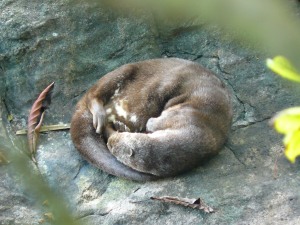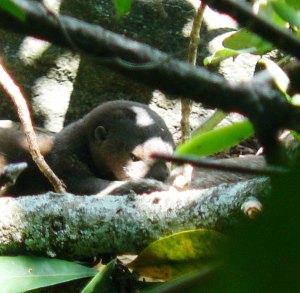Blog
July 30, 2013
The “otter” wonders of Rubondo
Author: Janice Reed-Smith, former researcher, ‘African Otter Outreach Project’, Director
Some days you wait patiently for the briefest of glimpses. Other days, after hours of watching them eat, frolic, rub, groom, squabble, and sleep; you just wish they would leave so you can move. But, no matter which kind of day it is, it is always a great day when you see the otters on Rubondo! And, you are always ready to do it again the next day. Many people in East Africa have never heard of them, even fewer of the thousands of visitors know otters exist in Africa. Yet Africa is home to four of the world’s 13 otter species.
In 2005 a colleague and I, accompanied by two individuals from the Tanzanian Wildlife Research Institute went to Rubondo Island to explore it as a location for research on the Spotted-necked otter (Lutra maculicollis). We had surveyed other national parks in Kenya and Tanzania but knew this park, with its protected shoreline and waters, would be a prime location for our plans to investigate habitat use and document more about otter behavior in lake environments. The island itself is stunning, a little known jewel in the Tanzanian park system. The wildlife abounds and as we soon discovered seeing the spotted-necked otters is not at all unusual. In fact, our first sighting of the otters occurred on day one; two animals, sunning themselves on top of large boulders at what we would discover was a resident group’s favorite resting and denning spot.
The study, which consisted of nine two month field sessions began in 2006 and continued through 2009. Follow up visits to pursue education outreach projects undertaken with TANAPA staff also took place in 2010 and 2011. Unfortunately, 2012 was missed but I am planning a return trip for November 2013 and I can’t wait. The visit is timed to be on the island when the otter cubs are first coming out of the den and moms are still confined to a restricted area making them easier to find and to observe.
We know from our research that the otters are still doing well in Rubondo. This is likely due to the complex habitat still found there, an abundant prey base, and protection from growing conflicts with human neighbors in other portions of their range. We also know from our behavioral observations that the spotted-necked otter is far more diurnal (active during the day) than previously reported and that their social system, while still a bit of a mystery, is more variable than thought.
I am “otterly” delighted to be able to check in on what is happening at the core otter area located quite near Rubondo Island Camp this year as well as work further with our TANAPA partners. Look forward to future blogs on the otters of Rubondo Island National Park, one of the few places you know you will see them!
![]()









































Add comment
Author: Janice Reed-Smith, former researcher, ‘African Otter Outreach Project’, Director
Some days you wait patiently for the briefest of glimpses. Other days, after hours of watching them eat, frolic, rub, groom, squabble, and sleep; you just wish they would leave so you can move. But, no matter which kind of day it is, it is always a great day when you see the otters on Rubondo! And, you are always ready to do it again the next day. Many people in East Africa have never heard of them, even fewer of the thousands of visitors know otters exist in Africa. Yet Africa is home to four of the world’s 13 otter species.
In 2005 a colleague and I, accompanied by two individuals from the Tanzanian Wildlife Research Institute went to Rubondo Island to explore it as a location for research on the Spotted-necked otter (Lutra maculicollis). We had surveyed other national parks in Kenya and Tanzania but knew this park, with its protected shoreline and waters, would be a prime location for our plans to investigate habitat use and document more about otter behavior in lake environments. The island itself is stunning, a little known jewel in the Tanzanian park system. The wildlife abounds and as we soon discovered seeing the spotted-necked otters is not at all unusual. In fact, our first sighting of the otters occurred on day one; two animals, sunning themselves on top of large boulders at what we would discover was a resident group’s favorite resting and denning spot.
The study, which consisted of nine two month field sessions began in 2006 and continued through 2009. Follow up visits to pursue education outreach projects undertaken with TANAPA staff also took place in 2010 and 2011. Unfortunately, 2012 was missed but I am planning a return trip for November 2013 and I can’t wait. The visit is timed to be on the island when the otter cubs are first coming out of the den and moms are still confined to a restricted area making them easier to find and to observe.
We know from our research that the otters are still doing well in Rubondo. This is likely due to the complex habitat still found there, an abundant prey base, and protection from growing conflicts with human neighbors in other portions of their range. We also know from our behavioral observations that the spotted-necked otter is far more diurnal (active during the day) than previously reported and that their social system, while still a bit of a mystery, is more variable than thought.
I am “otterly” delighted to be able to check in on what is happening at the core otter area located quite near Rubondo Island Camp this year as well as work further with our TANAPA partners. Look forward to future blogs on the otters of Rubondo Island National Park, one of the few places you know you will see them!